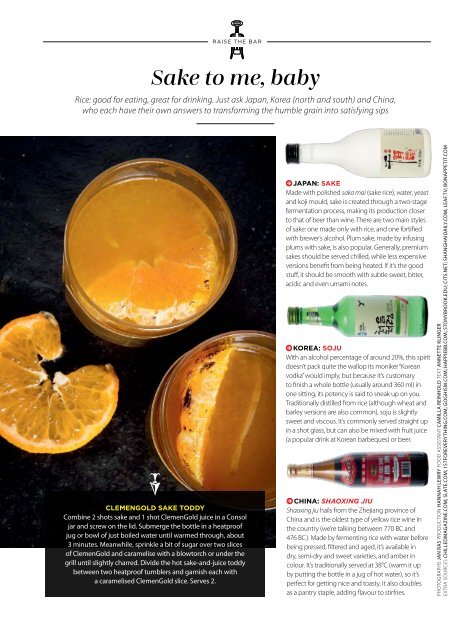Woolworths_Taste_July_2017
You also want an ePaper? Increase the reach of your titles
YUMPU automatically turns print PDFs into web optimized ePapers that Google loves.
RAISE THE BAR<br />
Sake to me, baby<br />
Rice: good for eating, great for drinking. Just ask Japan, Korea (north and south) and China,<br />
who each have their own answers to transforming the humble grain into satisfying sips<br />
CLEMENGOLD SAKE TODDY<br />
Combine 2 shots sake and 1 shot ClemenGold juice in a Consol<br />
jar and screw on the lid. Submerge the bottle in a heatproof<br />
jug or bowl of just boiled water until warmed through, about<br />
3 minutes. Meanwhile, sprinkle a bit of sugar over two slices<br />
of ClemenGold and caramelise with a blowtorch or under the<br />
grill until slightly charred. Divide the hot sake-and-juice toddy<br />
between two heatproof tumblers and garnish each with<br />
a caramelised ClemenGold slice. Serves 2.<br />
JAPAN: SAKE<br />
Made with polished saka mai (sake rice), water, yeast<br />
and koji mould, sake is created through a two-stage<br />
fermentation process, making its production closer<br />
to that of beer than wine. There are two main styles<br />
of sake: one made only with rice, and one fortified<br />
with brewer’s alcohol. Plum sake, made by infusing<br />
plums with sake, is also popular. Generally, premium<br />
sakes should be served chilled, while less expensive<br />
versions benefit from being heated. If it’s the good<br />
stuff, it should be smooth with subtle sweet, bitter,<br />
acidic and even umami notes.<br />
KOREA: SOJU<br />
With an alcohol percentage of around 20%, this spirit<br />
doesn’t pack quite the wallop its moniker “Korean<br />
vodka” would imply, but because it’s customary<br />
to finish a whole bottle (usually around 360 ml) in<br />
one sitting, its potency is said to sneak up on you.<br />
Traditionally distilled from rice (although wheat and<br />
barley versions are also common), soju is slightly<br />
sweet and viscous. It’s commonly served straight up<br />
in a shot glass, but can also be mixed with fruit juice<br />
(a popular drink at Korean barbeques) or beer.<br />
CHINA: SHAOXING JIU<br />
Shaoxing jiu hails from the Zhejiang province of<br />
China and is the oldest type of yellow rice wine in<br />
the country (we’re talking between 770 BC and<br />
476 BC ). Made by fermenting rice with water before<br />
being pressed, filtered and aged, it’s available in<br />
dry, semi-dry and sweet varieties, and amber in<br />
colour. It’s traditionally served at 38°C (warm it up<br />
by putting the bottle in a jug of hot water), so it’s<br />
perfect for getting nice and toasty. It also doubles<br />
as a pantry staple, adding flavour to stirfries.<br />
PHOTOGRAPHS JAN RAS PRODUCTION HANNAH LEWRY FOOD ASSISTANT CAMILLA REINHOLD TEXT ANNETTE KLINGER<br />
EXTRA SOURCES CHILLEDMAGAZINE.COM; SLATE.COM; 1STFOREVERYTHING.COM; GOGHISM.COM; HAPPIEBB.COM; STONYBROOK.EDU; CITS.NET; SHANGHAIDAILY.COM; LEAF.TV; BONAPPETIT.COM

















